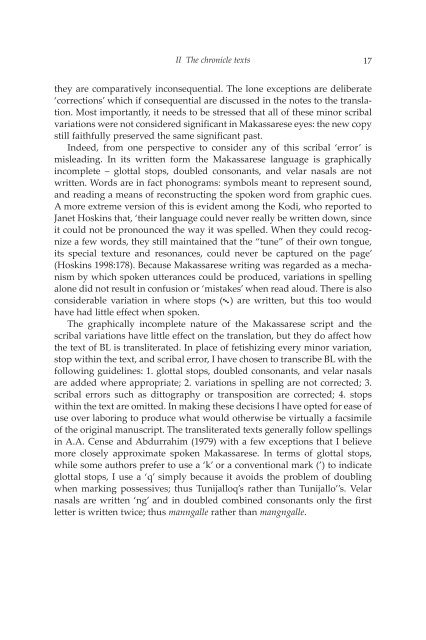A CHAIN OF KINGS - Books and Journals
A CHAIN OF KINGS - Books and Journals
A CHAIN OF KINGS - Books and Journals
Create successful ePaper yourself
Turn your PDF publications into a flip-book with our unique Google optimized e-Paper software.
II The chronicle texts 17<br />
they are comparatively inconsequential. The lone exceptions are deliberate<br />
‘corrections’ which if consequential are discussed in the notes to the translation.<br />
Most importantly, it needs to be stressed that all of these minor scribal<br />
variations were not considered significant in Makassarese eyes: the new copy<br />
still faithfully preserved the same significant past.<br />
Indeed, from one perspective to consider any of this scribal ‘error’ is<br />
misleading. In its written form the Makassarese language is graphically<br />
incomplete ‒ glottal stops, doubled consonants, <strong>and</strong> velar nasals are not<br />
written. Words are in fact phonograms: symbols meant to represent sound,<br />
<strong>and</strong> reading a means of reconstructing the spoken word from graphic cues.<br />
A more extreme version of this is evident among the Kodi, who reported to<br />
Janet Hoskins that, ‘their language could never really be written down, since<br />
it could not be pronounced the way it was spelled. When they could recognize<br />
a few words, they still maintained that the “tune” of their own tongue,<br />
its special texture <strong>and</strong> resonances, could never be captured on the page’<br />
(Hoskins 1998:178). Because Makassarese writing was regarded as a mechanism<br />
by which spoken utterances could be produced, variations in spelling<br />
alone did not result in confusion or ‘mistakes’ when read aloud. There is also<br />
considerable variation in where stops (.) are written, but this too would<br />
have had little effect when spoken.<br />
The graphically incomplete nature of the Makassarese script <strong>and</strong> the<br />
scribal variations have little effect on the translation, but they do affect how<br />
the text of BL is transliterated. In place of fetishizing every minor variation,<br />
stop within the text, <strong>and</strong> scribal error, I have chosen to transcribe BL with the<br />
following guidelines: 1. glottal stops, doubled consonants, <strong>and</strong> velar nasals<br />
are added where appropriate; 2. variations in spelling are not corrected; 3.<br />
scribal errors such as dittography or transposition are corrected; 4. stops<br />
within the text are omitted. In making these decisions I have opted for ease of<br />
use over laboring to produce what would otherwise be virtually a facsimile<br />
of the original manuscript. The transliterated texts generally follow spellings<br />
in A.A. Cense <strong>and</strong> Abdurrahim (1979) with a few exceptions that I believe<br />
more closely approximate spoken Makassarese. In terms of glottal stops,<br />
while some authors prefer to use a ‘k’ or a conventional mark (’) to indicate<br />
glottal stops, I use a ‘q’ simply because it avoids the problem of doubling<br />
when marking possessives; thus Tunijalloq’s rather than Tunijallo’’s. Velar<br />
nasals are written ‘ng’ <strong>and</strong> in doubled combined consonants only the first<br />
letter is written twice; thus manngalle rather than mangngalle.









![Am HaSefer [Volk des Buches] - Books and Journals](https://img.yumpu.com/20648352/1/174x260/am-hasefer-volk-des-buches-books-and-journals.jpg?quality=85)







